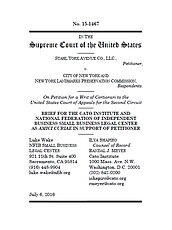Stahl York Avenue Co. v. City of New York
Learn more about Cato’s Amicus Briefs Program.
It should surprise no one that the government isn’t particularly good at respecting property rights. Still, the Constitution requires that property owners be provided with “due process of law” against arbitrary and unjustified deprivation of their right to put their property to beneficial use. According to several federal appellate courts, however, landowners lack such protections unless they show that they have a statutory “entitlement” to use their land. This is circular Humpty Dumpty logic. Indeed, that approach impermissibly presumes the legitimacy of restrictions, without considering whether they are lawfully applied. Most recently, the New York‐based U.S. Court of Appeals for the Second Circuit employed the “entitlement” theory to deprive a small developer of its right to upgrade run‐down apartment buildings. The NYC Landmarks Commission deprived Stahl York Avenue Company of its property rights by designating these nondescript buildings as landmarks—this despite a previous ruling that these exact buildings lacked any architectural or cultural merit worth preserving. Courts across the country are deeply split over landowners due‐process rights, so Cato and the National Federation of Independent Business have filed an amicus brief urging the Supreme Court to take up Stahl’s case. The “entitlement” theory itself contradicts longstanding Supreme Court precedent. “Long before the original States adopted the Constitution, the common law protected an owner’s right to decide how best to use his property,” wrote Justice John Paul Stevens in Moore v. City of East Cleveland (1977). Against that common‐law background, the Court in Euclid v. Ambler Realty (1926) held that an infringement on property rights “must find [its] justification in some aspect of the police power, asserted for the public welfare.” Indeed, 60 years later the Court reaffirmed that such infringements must “substantially advance legitimate state interests.” Agins v. City of Tiburon (1980). That due‐process test—whether a proposed land‐use regulation substantially advances legitimate state interests—is turned on its head when the regulation is presumed to be valid unless the owner can point to a specific statutory “entitlement” (permission from the legislature to use the land in that particular way). In addition, regulator‐friendly historical‐preservation rules have lead to various interests in cities that follow the entitlement approach to over‐preserve buildings across the nation. In Manhattan and Baltimore—two major cities within “entitlement” jurisdictions—nearly a third of the city mass is landmarked. Yet in places with different legal rules, like Philadelphia, Chicago, and San Francisco—pretty historic burgs!—only 1–5 percent of the city is landmarked. NIMBY (“not in my backyard”) interests abuse preservation powers in permissive jurisdictions to prevent development like Stahl’s. But over‐preservation isn’t economically harmless: it imposes significant negative effects on property values, tax revenues, affordable housing, and the environment. It also chills new residential construction and drives up the price of housing and rents, including in surrounding areas. Moreover, it foists highly expensive maintenance costs onto landlords who are required to keep everything appropriately “historic.” The character of cities changes over time, while over‐preservation freezes a city in time and ensures that economic redevelopment cannot occur. We urge the Supreme Court to take up this important question regarding a disturbing national trend, and ensure that property rights aren’t subject to the whims of clerks and municipal bureaucrats.
